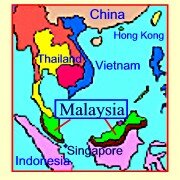|
|
|
|
|
|
 |
|||
| Size: 131,500 sq. km Population: 21.3million Weather: Hot & humid all year round Capital: Kuala Lumpur |
||||
|
1) First human inhabitants |
|||
| Location |
|||
|
Bordering Thailand on the North, Singapore on the South, West by the Strait of Malacca and the South China Sea on the East. |
|||
| Consisting of 11 States |
|||
|
Johor, Kedah, Kelantan, Melaka, Negri Sembilan, Pahang, |
|||
|
Location |
|||
|
Both situated at the northern part of Borneo Island, east by the Sula and Celebes seas, South China Sea on its north and west, and Indonesian on the south. |
|||
| Consisting of two States |
|||
| Sabah and Sarawak. |
|||
|
1) 1857 - 1887 |
||
|
|
||||
| (a) Jalan Parlimen (b) Jalan Sultan (c) Jalan Tun Sambanthan (d) Jalan Petaling (e) Jalan Cheng Lock |
(f) Jalan Pludu (g) Jalan Imbi (h) Jalan Sultan Ismail (i) Jalan Raja Chulan |
||
| LRT - Star LRT - Putra |
|||
|
Location: At the Padang area in the center of KL |
|||||
|
|
|||||
|
Location: At the other side of the Merdeka Square |
|||||
|
|
|||||
|
|
|||||
|
Location: Round the corner of the Square. |
|||||
|
|
|||||
|
Location: At the western part of Jalan Parlimen (Jalan means road) |
|||||
 |
|
||||
|
|
|||||
|
Location: Between Jalan Persiaran Mahameru and Jalan Kebun Bunga |
||||
|
|
||||
Location: Within walking distance from the Orchid Garden. |
||||
|
Location: Jalan Damansara |
||||
|
|
||||
|
Location: Jalan Sultan Hishamuddin, entrance from Jalan Lembah Perdana |
||||
|
|
||||
|
Location: Jalan Cheng Lock, Jalan Sultan, Jalan Hang Kasturi and Jalan Petaling. |
|||||
|
|
 |
||||
| Fruit stall selling "Durian" |
China Town street market |
||||
|
Location: Entrance from Jalan Bandar |
|||||
|
|
|||||
|
Location: Along Jalan Bandar (Jalan Tun HS Lee) |
|||||
|
|
 |
||||
|
Location: Along Jalan Bandar |
|||||
|
Location: Jalan Hang Kasturi |
|||||
|
|
|||||
|
From the Editor: |
|||||
 |
|||||
|
|
|||||
|
|
|
We would like to thank Dr. A. Yuen, Ir. F. Fan... for their contributions to this section. |
||
|
|
|
|